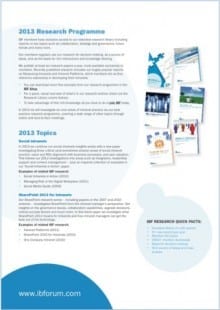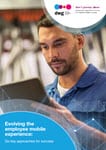Six key approaches for a successful employee mobile experience
The mobile digital workplace
The mobile experience of the digital workplace has evolved considerably over the past three years. Previously, mobility was an area which promised much in terms of benefits for both organizations and employees, but progress was always a bit patchy. But now many organizations are delivering an effective digital workplace through mobile, particularly where a significant proportion of employees are out in the field, customer-facing or on the move.
Our latest research report for DWG members, “Evolving the employee mobile experience: Six key approaches for success”, covers six ways organizations are ensuring their mobile digital workplaces are successful. Let’s explore each of these approaches in turn.
1. Embed mobile in key strategies and governance structures
Ensuring that organizations get the best value and employees the best experience from mobile apps and services, requires a consistent view and approach to enterprise mobility across different divisions, functions and initiatives. If different parts of an organization are off developing their own various mobile solutions, then the potential benefits are diluted.
Although a separate mobile strategy isn’t strictly necessary, mobile approaches need to be addressed and embedded within key enterprise-wide strategies such as the digital workplace, communication and collaboration.
As mobile usually has no overall user, there needs to be effective governance, with enterprise-wide standards, processes and policies to coordinate efforts.
2. Address security concerns and risks
Probably more than any other element, concerns over security and related legal, regulatory and compliance risks can derail an enterprise mobility initiative. A data breach can be very serious. Whether the risks are real or largely perceived is immaterial; you must get your risk-related stakeholders to buy into your approach. However, it is also important that you do not compromise the user experience. This is why many companies use data security companies similar to Digital Defense to help protect your systems from any data breaches that may occur.
Several approaches can help to address your risks, including:
- involving the appropriate stakeholders as early as possible in your plans to deal with concerns and plan to mitigate risks
- using Mobile Device Management (MDM) and Mobile Application Management (MAM) software
- developing clear information security policies and communicating these so that more employees are aware of the risks
- using appropriate encryption and authentication approaches
- providing training and user education.
3. Remove barriers around usage
A successful enterprise mobility programme relies on it being easy for employees to access mobile solutions. Therefore, work needs to be done to remove any potential barriers which may hinder your programme.
Approaches that can help remove barriers include:
- ensuring as many employees as possible can access solutions, potentially on their own devices
- improving connectivity, including having strong and reliable wi-fi and avoiding features that might impact performance
- establishing policies that provide clarity over usage and avoid any ambiguity for employees that might impact adoption.
4. Gain insight on mobile usage and needs
As with any digital workplace initiative, carrying out extensive user research helps teams to deliver the best possible solutions. Teams must fully understand how mobile devices are used by employees across a range of scenarios, including in front of customers, out in the field, in time outside work and even inside the office.
User research can be carried out through a number of methods, including interviews, workshops, observations, analytics and user testing. Understanding the data outputs from the research will allow teams to design better solutions and prioritize the most important use cases. A continuing programme of gathering user feedback and carrying out user testing can also help to drive continuous improvement.
5. Work with apps for maximum impact
Many teams with a more mature enterprise mobility programme or complex needs are choosing to build apps rather than rely purely on responsive design. The reasons for creating apps are numerous but include:
- enabling easier access to content while maintaining security – for example, not having to rely on a VPN connection
- providing a “one-stop shop” for critical services and content for convenience
- taking advantage of native features such as push notifications, geo-location and cameras
- providing a more controlled and potentially better user experience
- the ability to package custom and third-party apps together into an Appstore or pre-installed on a corporate device.
6. Keep an eye on the future
Mobile technology continues to be a fast-moving area, both in and out of the workplace. Considering how far we’ve come in the past decade, it is very difficult to predict where we will end up.
Teams need to monitor what is happening with enterprise mobility, in particular relating to:
- improvements in connectivity, with 5G waiting in the wings
- the Internet of Things, with many connected devices in smart buildings and the mobile device a logical place to interact with the physical workplace
- the increasing use of wearables including watches, safety equipment and more
- Augmented Reality and Virtual Reality
- Artificial Intelligence, which will drive highly intelligent systems and personalized experiences.
Download the free executive summary
Mobile continues to evolve rapidly both inside and outside the workplace. By following the six approaches above, organizations will find themselves on a firm footing to take advantage of the future opportunities enterprise mobility provides.
Why not download the free executive summary from the DWG research report “Evolving the employee mobile experience: Six key approaches for success”?
RESEARCH AND RESOURCES
- FREE EXECUTIVE SUMMARY: Evolving the employee mobile experience: Six key approaches for success
- FREE REPORT: Digital Workplace 2030: Preparing now for the digital worlds of work to come
- FREE REPORT: Digital workplace integration: Key approaches to drive benefits
TAKE THE NEXT STEP
Evolving the employee mobile experience
Categorised in: Employee mobile



